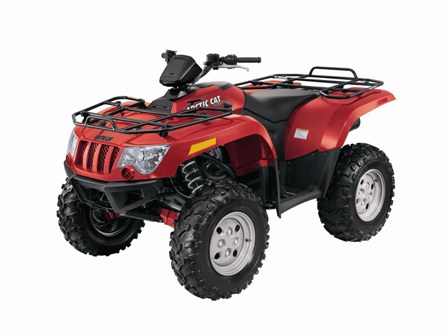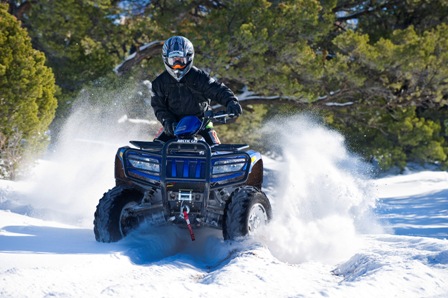
For those who have been waiting for Arctic Cat to offer power steering on an ATV, the wait is over. Six new 2010 models will come with Variable Assist electronic Power Steering (VAPS): three 550 models (including one TRV), and three 700 machines (including one TRV), which will arrive at dealerships beginning around March 1.
Each VAPS-equipped machine will have an “S” designation on the end of an already cumbersome alpha-numeric name (e.g. TRV 550 H1 EFI S). Each is identical to their non-VAPS mates in every way except for the power steering unit and necessary wiring (and of course the estimated $750 price premium).
The unit consists of a sealed, brushless motor that acts like a torque converter, and fits snuggly in the front of the chassis (above). An input shaft on the top attaches to the ATV’s steering post, while and output shaft on the bottom connects with the remaining steering linkage.
A cutaway of the brushless motor, with the input shaft. The entire VAPS unit weighs 14 lbs. and is designed with a lifespan that’s 10-times longer than their ATV, according to Cat.
When the rider turns the handlebars, an electronic control unit (ECU shown above) measures steering input force in relation to tire resistance and vehicle speed, then provides the appropriate assist to the steering column via the electronic motor.
Arctic Cat has programmed the ECU to maintain a light input effort, yet retain enough “feel” so that the rider can still detect what the tire contact patch is doing in relation to the terrain. This is the “Variable” element that Arctic Cat has wisely used to differentiate its system from competitors. I could easily feel the variability by playing at the extremes.
With the machine idling on pavement, you can turn the handlebars full lock-to-lock with a fraction of the effort required on a non-VAPS machine. But when cruising down a loose-gravel road at 40 mph – when a linear EPS system would deliver too much assist – the VAPS-equipped ATV delivers only the faintest detectible assist, leaving the rider with a solid idea of how much traction remains on the front end.
Arctic Cat chose Moab, Utah, for their media unveiling in December, and for good reason. Rocky, rugged high-desert country with riding conditions that range from rock-crawling to high-speed hammering, Moab was an ideal environment to test VAPS and to understand its remarkable advantage.
I must admit I wasn’t one of those people clamoring for power steering. I’d never tried and, nor did I believe I needed it. This made my experience all the more enlightening and, frankly, overwhelming.
The difference between VAPS and no EPS is night and day. Steering effort is cut in half…and maybe more. The difference is most noticeable when negotiating rocks, tight turns and heavy-steering situations, and it’s clear to me other situations where I would be equally impressed: plowing snow; negotiating tight woods (especially with fully-loaded racks); and anytime when riding with a fully-locked differential.
Only with power steering would I attempt to ride down these rocks one-handed, while trying to point at the Arcticinsider decal on my visor. Seriously.
I don’t have experience with other systems, but Cat claims VAPS has a quicker assist speed, but without the “detached,” full-power-in-all-conditions feel that apparently is common to other brands. For what it’s worth, the other journalists in attendance agreed with Cat’s assessment.
Simply put: The comfort and ease of riding with VAPS is so noticeable, it left me wondering why Arctic Cat waited so long to bring it.
In fact, Cat spent three years developing their VAPS system, which explains why they’re a little late to the party but making a grand entrance in terms of bringing a highly-optimized and refined product.
Arctic Cat offers power steering on six different 2010 model year ATVS, including two TRV models like the 700 shown above.
